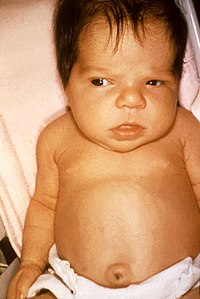
Photo from wikipedia
This study aimed to describe fetal, neonatal, and post-neonatal mortality and associated factors in participants of the 2015 Pelotas (Brazil) birth cohort. The child mortality sub-study followed up all deaths… Click to show full abstract
This study aimed to describe fetal, neonatal, and post-neonatal mortality and associated factors in participants of the 2015 Pelotas (Brazil) birth cohort. The child mortality sub-study followed up all deaths in the first year of life. Data were collected on intrauterine fetal deaths (weight ≥ 500g and/or gestational age ≥ 20 weeks), neonatal deaths (< 28 days of life), and post-neonatal deaths (from 28 days to the end of the first year of life). Descriptive analyses using the Pearson chi-square test and a multinomial logistic regression to estimate the risk of fetal, neonatal, and post-neonatal deaths compared to live infants in the cohort (reference group) were performed. Data from 4,329 eligible births were collected, of which 54 died during the fetal period. Of the 4,275 eligible live births, 59 died in the first year of life. An association between fetal, neonatal, and post-neonatal deaths (OR = 15.60, 7.63, and 5.51 respectively) was found, as well as less than six prenatal consultations. Compared to live infants, fetal deaths were more likely to occur in non-white mothers, and neonatal deaths were 14.09 times more likely to occur in a preterm gestational age (< 37 weeks). Compared to live infants, infants that were born in a C-section delivery had 3.71 increased odds of post-neonatal death. Additionally, neonatal deaths were 102.37 times more likely to have a low Apgar score on the fifth minute after birth. These findings show the need for early interventions during pregnancy, ensuring access to adequate prenatal care.
Journal Title: Cadernos de saude publica
Year Published: 2019
Link to full text (if available)
Share on Social Media: Sign Up to like & get
recommendations!